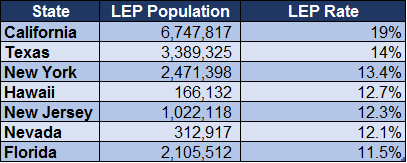Language Barriers in Health Care

With just under 62 million people of the United States population having limited English Proficiency, how are health care providers breaking down the language barrier?
Overview
As of 2012, 21% of individuals in the United States speak a language other than English at home and 8.5% have Limited English Proficiency (LEP). LEP is defined as being able to speak English less than very well. Of the 21% (61.9 million people) who speak a language other than English at home, Spanish is the most common language used (62%). The next most common languages are Chinese (5%), Tagalog (3%), Vietnamese (2%), French (2%), Korean (2%), German (2%), Arabic (2%), and Russian (1%).
LEP individuals reside all over the country, but there are seven states that have a higher concentration. At least 10% of the population in these states
is comprised of LEP individuals. California currently has the highest LEP
rate in the country at 19%.
Health Coverage and Care Problems
Adults and children in the United States with LEP are significantly more likely to be uninsured than English speaking individuals. In fact, half of adults with LEP are uninsured and children with at least one LEP parents are twice as likely to be uninsured.
These high under coverage rates are directly related to the education levels and jobs many LEP individuals have. Although two-thirds of LEP individuals live in a family with at least one full-time worker, LEP adults typically hold jobs in the service, manufacturing, or construction industries. These industries tend to have lower wages than management or professional positions, causing the poverty rate among the LEP population to drastically increase. In Los Angeles and New York City especially, the need for benefits such as health care is more closely linked to limited English proficiency than anything else. The low-wage jobs that often do not provide health insurance combined with the poverty rates lead to much lower private coverage rates for LEP adults and their families.
Individuals with LEP that do acquire insurance are less likely than English proficient individuals to seek medical care. They often report negative experiences which indicate language barrier issues with their health care providers. This language barrier along with low education, citizenship status, and high poverty levels contribute to a significant part of the LEP population not receiving any healthcare.
The Affordable Care Act
With the introduction of the Affordable Care Act (ACA) earlier this year, Medicaid expanded coverage to provide Medicaid eligibility for individuals with incomes up to 133% of the federal poverty line. Those without employer coverage can now buy insurance through health insurance exchanges, which cover up to 400% of the federal poverty line. States are also now required to provide a simplified process for enrolling in Medicaid and exchange coverage. This allows LEP individuals to apply through multiple avenues, as well as having access to information in their language. All language services are provided at no cost to the individual.
About Voiance Language Services
Voiance Language Services, LLC is a leading Phone Interpretation provider to contact centers. Operating a network of secure interpreter contact centers with over 1,000 seats, Voiance offers 24/7 Phone Interpretation in over 200 languages, Translation and Localization in over 100 Languages, and Video Remote Interpretation. Voiance’s parent company CyraCom International, Inc. has been in business since 1995 and is the largest provider of Phone Interpretation with operations solely in the United States.